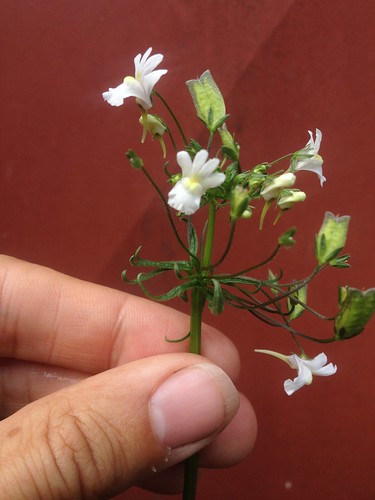RECENT ARTICLES
- CEBRA: An optimised and standardised sampling protocol for BioBlitz
- Stop it people, the plural of anecdote IS data!
- That's no pollinator, that's a flower visitor
- Add a scale to your macro photos
- What to photograph when counting the wild
- Imagine counting the wild on EVERY street in a city!
- My wild counting workflow
- A butterfly flew through
- Why iNaturalist observations without photos can be research grade
- Why you shouldn’t use a spreadsheet for data entry
- All articles ...
Eradicating a weed is easy, if you get it early
written Mar 18, 2014 (last updated Sep 9, 2021) • by Jon Sullivan • Category: Wild Changes

Last week I found on the Lincoln University campus the first wild record outside of Dunedin of the naturalised South African plant, Nemesia floribunda. It was flowering, and about to seed, along the northern side of the university’s Engineering Demo lecture room, west of the NRE029 lab.
According to Flora IV, this pretty annual weed was first found in the wild in NZ in 1958, in Dunedin, and occurs "in and around scrub, forest margins, sometimes common." It has remained restricted to the wider Dunedin area since then and all wild herbarium records and observations are from the Dunedin area. Until now.
I found it growing at Lincoln University on fresh gravels around the recently installed prefab toilets. The Royal Wolf company that hired us the toilets has an office in Dunedin. Perhaps the seed came with those toilets.
I’ve not found any more plants yet. Canterbury doesn’t need another weed so I’d encourage you all to keep a close eye out for it if you live or work in the area, and pull it out if you see it. If it made it to Lincoln, it may well have made it to Christchurch as part of the influx of machinery for the post-earthquake city rebuild

You can add observations and photos to iNaturalist NZ of anything unusual that you find. iNaturalist NZ is an online nature watching community that uses the open source iNaturalist system to open people’s eyes to the species around them. Since we launched 18 months ago, more than 50 species not previously known to be in New Zealand have been observed, including a new native species of moss and the recent new incursion of the giant willow aphid to NZ that was first observed on iNaturalist NZ in December.
Update 9 September 2021
It’s been over seven years since I pulled out that Nemesia floribunda from Lincoln University. There still hasn’t been another plant seen at Lincoln University, and I remain convinced that my action likely prevented it establishing in Lincoln. However, this will be short-lived, as the species was detected in Lincoln town last year, in February 2020, when one plant was found by a new housing subdivision development on Lincoln’s eastern edge.
That’s likely because the species established on a railway overbridge in western Christchurch in 2017 three years after I found it at Lincoln, and it wasn’t controlled. It has since been spreading out across the city. This is only about 15 km away from Lincoln and there is a lot of traffic in and out every day (and construction machinery). It will be futile to attempt to keep Nemesia floribunda out of Lincoln now.
The bigger concern is the Christchurch Port Hills, with its many rocky outcrops with rare native plants. In these habitats Nemesia floribunda is expected to thrive, as it has done on Otago Peninsula by Dunedin. With the plant spreading and increasing in abundance in Christchurch, keeping it off the Port Hills is going to be difficult (that’s an optimistic assessment—it’s likely impossible now).
That’s the thing about weeds, and all invading pests. There’s a narrow window right when they first arrive when they are still vulnerable, and when prompt action (and a dash of luck) can eradicate them. After that, restricting their spread is vastly more difficult and expensive. With the many keen naturalists active on iNaturalist NZ, we’re getting much better at spotting these arrivals early. We’re still generally awful at taking swift, coordinated action (but that’s a story for another article).